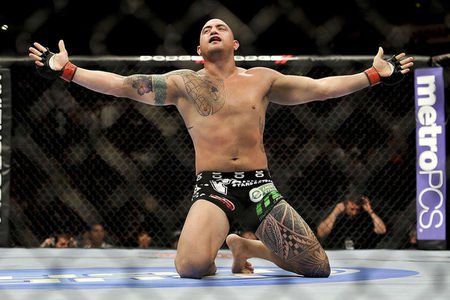
(Click chart for full-size version. For previous Databombs, click here.)
By Reed Kuhn, @Fightnomics
Last week we broke down the UFC Featherweight division in key striking metrics. This week we’ll look at the largest (numerically) UFC division, the Lightweights. A full explanation of the chart and variables is included at the end of this post.
The Winners
Sniper Award: Daron Cruickshank finally showed off his striking skills in his second UFC appearance against Henry Martinez on the UFC on FOX 5 card in Seattle. With nearly 50% accuracy, he looked like he was practicing on a heavy bag before mercifully dropping an iron-chinned Martinez with a head kick KO. Interestingly, the “Detroit Superstar” is set to face another division sniper, John Makdessi, in March at UFC 158.
Energizer Bunny Award: Tim Means is two wins into his UFC career, and has almost doubled the standing output of his two opponents. He also maintained good accuracy and scored two knockdowns in those performances.
Biggest Ball(s) Award: Melvin Guillard has been punching above his weight for a long time in the UFC. To date Guillard has 12 knockdowns, putting him 3rd all-time in the UFC behind Anderson Silva and Chuck Liddell. Not bad for a lightweight.
The Losers
Swing and a Miss Award: Justin Salas has landed just 15% of his power head strikes in his first two UFC fights and appears at the bottom of the graphed fighters. But (dis)honorable mention also goes to Mitch “Danger Zone” Clarke, who is 0 for 47 in power head strikes through nearly 25 minutes of Octagon time. Unfortunately, because Clarke was so far into the danger zone, I couldn’t fit him onto the graph.
Smallest Ball(s): 15 of the 55 lightweight fighters graphed have yet to score a knockdown in their Zuffa appearances, not an unusual number for a lower weight division. But Mark Bocek and Thiago Tavares have failed to do so despite over two hours of Octagon time each. Given that both fighters tend to be outpaced by their opponents, perhaps they need to try planting their feet.
Starnes Award for Inaction: Reza Madadi has had solid accuracy through his first two UFC appearances, but had less than half the striking output of his opponents. He’ll need to step on the gas if he doesn’t want to drop close decisions in the future.
Also Noteworthy
In a division made famous by strong wrestlers, it’s no surprise that the top ranked fighters aren’t pure strikers. But keep an eye on Anthony Pettis, who will bring a striking advantage to his recently announced featherweight fight against current champion Jose Aldo. Aldo has had sharper striking than most of his opponents to date, so this will be an interesting challenge.
Despite his recent UD loss to Benson Henderson, Nate Diaz shows impressive accuracy and the ability to push the pace — at least, when he has vision in both eyes. He’s down but not out.
For those counting red bubbles, the Lightweight division has a high 27% share of left-handers, about three times the normal rate for the population.
The lightweight division is often thought to be the deepest in the UFC, but we’ll have to see how the new additions play out against tried-and-true veterans.
How the Analysis Works:
In order to understand standup striking performance, which is more multifaceted in MMA than it is in boxing, I need to boil down a few of the most important variables that determine success as a striker. These are fairly uncomplicated variables in isolation, but together they can summarize a fighter’s overall capabilities. Here, I’ve focused on three fundamental, offensive metrics:
Accuracy: I’ve used power head striking accuracy (as opposed to body or leg strikes, or jabs to the head), where the average for UFC Lightweights is about 26%. Certainly, great strikers can attack the body and legs, but the most likely way to end a fight by strikes is by aiming at the head. And in order to keep this comparison apples-to-apples, we can’t have a guy that throws a lot of high accuracy leg kicks skewing his accuracy stat. The accuracy of the power head strike is a great indicator of a fighter’s striking prowess, and there’s a wide range within a single division. This is the vertical axis, so more accurate fighters are higher in the graph.
Standup Striking Pace: Prior analysis reveals that outpacing your opponent is a key predictor of success, and certainly correlates with winning decisions as it reflects which fighter is dictating the pace of the fight. Here, I’ve used the total number of standup strikes thrown as a ratio to the same output from a fighter’s opponents. All strikes attempted from a standup position are counted, including body shots and leg kicks. This is the horizontal axis in the graph, and the average for the whole division must be 1, so fighters with superior pace appear further to the right.
Knockdown Rate: The objective of every strike thrown is to hurt your opponent, and knockdowns reflect a fighter that has connected with a powerful strike. I’ve used the total number of knockdowns a fighter landed divided by the number of landed power head strikes to see who does the most damage per strike landed. The size of the bubble for a fighter indicates their relative knockdown rate; the bigger the bubble, the higher their knockdown rate. The very small bubbles indicate fighters who have yet to score a knockdown in their Zuffa fights.
The data includes all UFC, WEC, and Strikeforce fights through 2012, including UFC 155. Some of these fighters competed in other weight classes or at catchweight, but for the purposes of this analysis, that data was still included and analyzed. Because of the size of the division, fighters with only one fight were not included in the graph.
For more on the science and stats of MMA, follow @Fightnomics on Twitter or on Facebook. See more MMA analytical research at www.fightnomics.com.



